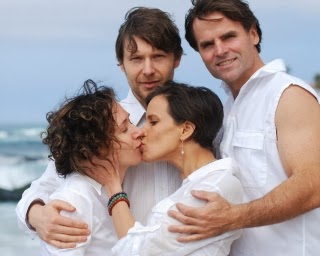Poly greeting cards
It’s
a warm summer day on the beach. Teenagers hangout on the pier, making
plans about what to do later on in the evening. Attractive women wear
their best bathing suits, proud of the year round workout regimens
they went through to attain their look. Waves roll onto the shore as
children run away, pretending there’s a sea monster after them. A
man walks down the boardwalk with his lady holding his arm, taking in
this peaceful scene. The couple kiss and flirt with each other.
They’re obviously on a date. Together they spot a woman in the
distance and wave her over. She smiles and approaches quickly,
obviously happy to see them. As she reaches them, something strange
happens that draws stares from everyone around. She kisses the man
squarely on the lips. Then something even stranger happens. She
kisses the woman squarely on the lips. This scene brings whispers and
sideways looks from nearly everyone in sight, but the triad doesn’t
even seem to notice as they walk down the beach hand in hand in hand.
They find a bench and the man buys lunch at a vending cart while the
two women chat and smooch. Later the first woman excuses herself to
the ladies room leaving the man alone with the second woman. He lays
his head on her lap and they gaze into the others eyes. Together the
three of them leave the waterfront, presumably for the couples’
home, with many confused eyes following them.
Dates
like this are becoming more commonplace in our society. Sometimes the
dynamics differ, but the premise is still the same. More than two
people in a romantic relationship with everyone aware of the
circumstances is called “Polyamory”. The devotees of this
practice swear by the closeness it brings to their existing
relationships and the personal discovery they undergo to maintain it.
To polyamorous people, it’s a healthy, enriching, beautiful
relationship option. In our society, however, polyamory is often
frowned upon and even outright vilified because of it’s opposition
to the idea that monogamy or being single are the only relationship
choices.
Bold illustration of a poly lesbian triad
The
word Polyamory is a hybrid word combining the Latin words “poly”,
meaning many, and “amor”, meaning love. “Polyamory” literally
translates into “many loves”. Polyamory also has symbols of
pride, such as the tri-colored flag designed by Jim Evans. The flag
is designed with three horizontal stripes, each a different color,
and the “pi” symbol in the center. Pi is the latin letter “P”,
which is the first letter in polyamory-not very imaginative but it
serves it’s purpose of identifying polyamorous people and their
supporters. The very idea of being in love with more than one person
is absurd to some people. Because polyamory isn’t widely recognized
as a legal relationship choice as of today, marriages of more than
one man and one woman are not legal. Thus, a good many polyamorous people
are unmarried because they choose not to alienate any of their partners but, that doesn’t mean they are alone.
The Pod From Showtimes Polyamory: Married and Dating
In
America there are over 100 support groups and email lists. This poly
network shows how quickly polyamory has gained in popularity since
the 1970’s. Being polyamorous, especially in America, is difficult
and having other like-minded people to confide in is invaluable.
Because so many people have expressed curiosity about polyamory, the
cable network Showtime produced a reality show on the subject
“Polyamory: Married and Dating”(Saraiya, 2012, para. 4) giving a
perspective of two different poly-families. The “Triad” of
Lindsey and Anthony Cristofani who are both dating Vanessa Carlisle
is the more typical poly-relationship whereas the “Quad” of
Kamala Devi, Jennifer Gold, Tahl Gruer and Michael McClure, who refer
to themselves as “The Pod”, are seen less but scrutinized much
more harshly.
Being
polyamorous has several benefits exclusive to its practice. New
Relationship Energy (Cook,n.d. para. 7), which is often a forbear to
love, is never scarce. Intense passion and intimacy is experienced in
both the primary and the secondary relationships. Falling in love is
a feeling that never grows stale and, having that freedom while
having the security of your primary significant other, if you have
one, is beyond elating. The most beneficial aspect of polyamorous
relationships is what one learns about oneself and their partner.
Having more than one person express themselves about another’s
virtues and faults helps allows for greater understanding of the
self, not least when the people expressing themselves matter on an
emotional level. Seeing ones partner develop romantic feelings for
another and confiding in them about it reinforces not only the
relationship but the friendship as well.
I fly my poly flag proudly
Despite
the benefits of polyamory, society clings to it’s misconceptions
about the practice. The most recurring assumption is that polyamory
is solely about sex and infidelity. Only slightly less recurring is
that polyamory is not about love or intimacy. Both assumptions are
completely false. Laymans often confuse polyamory with the sexually
oriented “Swinging” (“Polyamory FAQ,” n.d., para. 4).
Swinging is a recreational, sexual hobby usually consisting of four
or more people. Polyamorists, however, place sex as a tertiary need
with love and friendship being far more important.
With
the way the world is evolving, poly-families are becoming more and
more typical within our society. Some judge the practice as immoral
but their opinion is more often than not born of ignorance on the
subject. Before forming one of your own, it would be wise to search
for more information and educate yourself about it. Whether this blog
post or in a` polyamory forum online, there is no shortages of
references for those even mildly curious about the polyamorous
lifestyle.
References
Cascade
Spring Cook. (2009). Initated By a Woman
Loving
More. (n.d.). Loving More Polyamory Frequently Asked Questions or
FAQ
Sonia
Saraiya. (2012).
Polyamory:
Married and Dating
Pictures
http://www.cafepress.com/+polyamorous+greeting_cardshttp://www.autostraddle.com/what-do-you-mean-youre-not-monogamous-82317/



